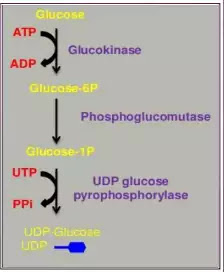GLYCOGEN METABOLISM
DEFINITION:
·
Glycogen is
readily mobilized storage form of glucose.
·
It is very the large branched polymer of glucose residues that can be broken down to
yield glucose molecule when energy is needed.
·
Most of this glucose is linked by α-1,4-glycoside bonds and α -1,6-glycosidic bonds.
·
It is branched at about every tenth residues.
GLYCOGEN CHEMISTRY:
 |
| GLYCOGEN CHEMISTRY |
·
Glycogen’s molecular weight is about 107
Da and consist of polysaccharides chain each containing about 13 glucose
residues.
·
Chain may be branches (inner layer) or unbranched
(outer layer) and are arranged in 12 concentric circles.
Glycogen Chemistry
GLYCOGEN STORAGE SITES
·
Glycogen is stored mainly in the liver and muscles.
·
Liver contact of glycogen is greater than muscles.
·
Since the muscles mass of the body is considerably
greater than that of the liver, about three-quarters of total body glycogen
is in muscles.
Function Of Glycogen Metabolism
 |
| Function Of Glycogen Metabolism |
PROCESSES OF GLYCOGEN METABOLISM
There are two
main processes in glycogen metabolism.
·
Glycogenesis
·
Glycogenolysis
Glycogenesis and Glycogenolysis
 |
| Glycogenesis and Glycogenolysis |
GLYCOGENESIS
Glycogenesis
is the synthesis of glycogen from glucose.
There are four different steps of glycogen synthesis.
·
Activation of Glucose
·
Initiation
·
Elongation
·
Glycogen Branching
STEP-1: ACTIVATION OF GLUCOSE:
1. The enzyme “Hexokinase” (in muscles) and
“glucokinase” (in liver) convert glucose to glucose-6-phosphate by taking one
phosphate group from ATP.
2. Phosphoglucomutase catalysis the conversion
of glucose-6-phosphate to glucose-1-phosphate.
3. Uradine diphosphate glucose (UDP) is
synthesized from glucose-1-phosphate and UTP by UDP-glucose pyrophosphate.
Step-1: Activation of Glucose
 |
| Activation of Glucose |
STEP-2: INITIATION:
·
A small fragment of pre-existing glycogen must act
as a primer to initiate glycogen synthesis (glycogenesis) called as
“Glycogen”.
·
Glycogen receives glucose from UDP. The hydroxyl
group of OH of amino acid tyrosine of Glycogenin is the site at which the
The initial glucose unit is attached.
Step-2: Initiation
 |
| Initiation |
STEP-3: ELONGATION:
·
Glycogen synthase is responsible for the formation
of α-1,4-glycosidic
linkages.
·
The enzyme transfer the glucose from UDP-glucose to
non-reducing end of glycogen to form an α-1,4-glycosidic linkage
·
es.
STEP-4: BRANCHING:
·
Glycogen synthase can catalyze the synthesis of
linear unbranched molecules with α-1,4-glycosidic linkages.
·
Glycogen is a large branched tree-like structure.
·
The formation of branches is brought about by the action
of a branching enzyme, namely “glycosyl-4,6-transferase”.
·
It only makes a linear structure, not a branched structure.
·
If any chain continues from C-1 to C-16. so
enzyme “glycosyl-4,6 linkage transferase” will cut the chain from C-10 to
C-16 and join it with the carbon of another chain of C-7 to make branched
structure. In other words “glycosyl α-1,4-linkage
transferase” will be converted into “glycosyl α-1,6-linkage
transferase”.
·
This leads to the formation of a new non-reducing
ends, besides the existing one.
·
Glycogen is further elongated and branched, by the
enzymes “Glycogen synthase” and “glycosyl-4,6 linkage transferase”





0 Comments